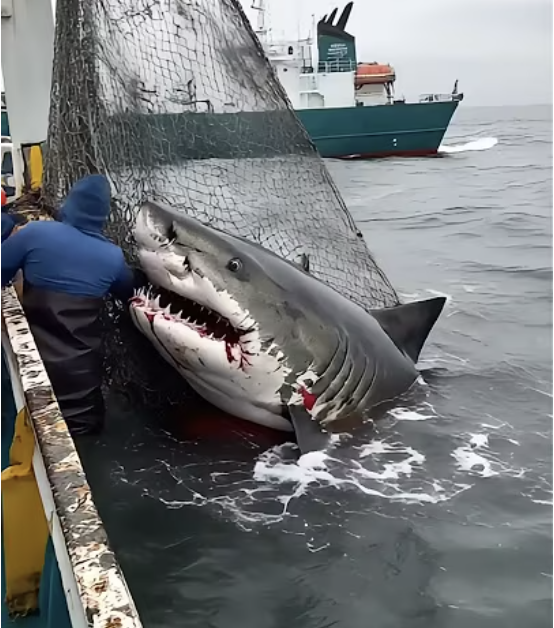Off the coast of South Africa, in the crystal-blue waters of the Atlantic, a team of marine biologists set out on a mission that was as courageous as it was compassionate. A local fisherman had spotted a great white shark tangled in a web of abandoned fishing nets. With the animal growing weaker by the hour, time was critical. Led by Dr. Emily Carter, the team was committed to giving the magnificent predator a second chance at life.

As their research vessel approached the shark’s reported location, a heavy sense of anticipation hung in the air. Though the ocean surface was calm and the sunlight glistened over the waves, the urgency of their task pressed on them. Dr. Carter, a respected authority in shark behavior, gathered her team for a final briefing. “We’re here to help—not harm,” she reminded them, her tone both calm and determined.
It didn’t take long before they spotted the creature. Its dorsal fin broke the surface, barely moving. Once a symbol of power, the shark now appeared frail and trapped. The fishing nets had dug deep into its skin, and every movement only tightened the trap. The team quickly deployed a small boat, equipped with cutting tools and poles, to get close to the struggling animal.
As they approached, the shark fixed its gaze on them—alert, aware, and clearly in distress. Dr. Carter expertly steered the dinghy into position while her team began carefully snipping at the tightly wound lines. Every move was precise, every gesture cautious, as they worked to free the shark without inflicting more injury. Remarkably, the shark remained calm, as if it understood they meant no harm.
Minutes passed like an eternity. Each cut brought them closer to success, and with every strand removed, the tension slightly eased. Then, just as the last bit of net was about to fall away, the unexpected occurred. With a surge of raw energy, the shark exploded into motion, thrashing wildly in a primal, instinctive reaction to its sudden release.
The small boat rocked violently, nearly overturning from the force. The biologists clung to the edges, their hearts pounding as they fought to stabilize the dinghy. For a few breathless seconds, chaos took over. But just as quickly, the shark stopped. It hovered near the surface—free.
What happened next stunned everyone. Instead of darting away, the shark began circling the boat slowly, its movement graceful and deliberate. It was as if the animal recognized their efforts—offering a wordless moment of connection. The team watched, transfixed, as the great white turned and disappeared into the deep.
Back aboard the vessel, cheers erupted. Team members hugged, exchanged high-fives, and celebrated the success of their dangerous but rewarding mission. Dr. Carter stood quietly, staring out at the open ocean, feeling a deep sense of fulfillment and renewed respect for the creatures she had dedicated her life to protecting.
In the days that followed, news of the daring rescue spread quickly, capturing global attention. It was a powerful example of human empathy and the often-underestimated intelligence of marine life. The moment served as a vivid reminder of our responsibility to protect nature—and the awe-inspiring moments that can happen when we do.




